
It’s a familiar sight: your son or daughter, hunched over their iPhone, furiously texting. You’re dying to know who they’re texting and what they’re saying. But should parents monitor kids’ texts? And what’s the best way to see their texts without overstepping?
Texting exposes kids to risks such as phishing scams, cyberbullying, and online predators. That’s why it’s helpful for parents to stay involved when their kids begin texting independently.
This guide will show you how to see your child’s text messages on iPhone using iCloud, Apple’s parental controls, and third-party apps like BrightCanary — the best app to monitor a teenager’s iPhone effectively.
📲 Keep your child safe and on track. Try BrightCanary for the best text message monitoring on iPhone. Download the app today.
Yes, but it depends on how you do it. Parents should stay involved in their child’s texting habits without violating their trust. We’re not talking about spying; we’re talking about ensuring your child’s safety.
Gen Z is notoriously averse to phone calls, with as many as 75% preferring to text instead. But with the popularity of this communication method comes a host of safety concerns. Parents need to understand the risks their children may encounter over text and take steps to help them stay safe.
Your child’s privacy matters, but so does their safety. Instead of reading every message (who has time for that?), consider a text monitoring app that alerts you to concerning content while giving your child independence.
BrightCanary makes monitoring iPhone text messages easy. It flags issues like bullying, explicit content, and drug references in real time.
By now, you might be wondering, “Okay, texting is risky. But how do I see my child’s text messages on iPhone?” Here are your options:
This method is also called mirroring. To do it:
With BrightCanary, you can also monitor every app your child uses, including Snapchat, Discord, Google, and YouTube.
Other apps promise to let you supervise your child’s text messages, but many of them aren’t very reliable or easy to use.
For example, Bark requires that you install a desktop app on your home computer, then plug in your child’s phone. You can only monitor text messages on iPhone when your child’s device is home and on the same WiFi as your computer.
BrightCanary is different. The app offers two ways to monitor your child's text messages on Apple devices:
Learn more about how BrightCanary works, or download the app and start your free trial today.
Don’t spy on your child’s texts. If they find out you’ve invaded their privacy without their knowledge, they’re less likely to come to you if they’re in trouble.
Instead, be upfront about monitoring. Explain when and why you’re going to review their text messages.
If you’re stumped, consider this conversation starter: “I respect your privacy, but I also need to make sure you’re safe. Here are the situations where I may need to look at your messages.”
You should also be clear about your red-flag concerns, such as suicidal thoughts, bullying, and involvement with a predator.
Let them know that if you find anything worrisome, you’ll address the issue together.
After you’ve established a plan for monitoring your child’s messages, consider writing it into a digital device contract. This will solidify expectations on both sides and help create accountability.
You can log into their iCloud account on your desktop or iPad. However, most experts recommend against going behind your child’s back. BrightCanary provides a transparent way to monitor messages while maintaining trust.
BrightCanary is the best iPhone parental monitoring app because it provides comprehensive insights on Apple devices, and it also monitors other messaging and social media apps your child uses.
The safest chat apps, such as Messenger Kids and Kinzoo, don’t allow strangers to message your child. This limitation minimizes some concerns, but it’s still a good idea to play a hands-on role in monitoring their messages.
It depends on your child’s maturity level and the trust you've established with them. As children grow and demonstrate responsible behavior, it's essential for parents to gradually grant more privacy to foster independence.
It's a good practice to maintain open communication with your child about this topic and adjust your approach based on their development and the unique dynamics of your relationship.
You can monitor your child’s text messages and social media messages on Android using Google Family Link.
While texting is a wonderful way for kids to maintain friendships and exercise their independence, there are also a number of risks. It’s advisable to maintain some level of involvement in your child’s text messages, using a combination of text message monitoring and open communication.
Parental monitoring apps like BrightCanary give detailed insights into your child’s texts. Download BrightCanary on the App Store to get started.
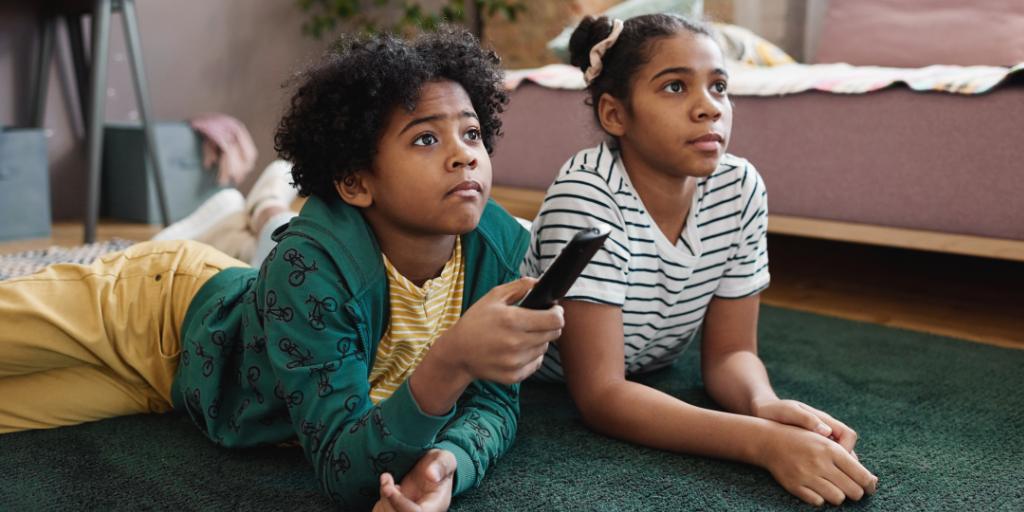
Eight- to ten-year-olds are a hard demographic to find shows for. It’s the age when kids start to be aware when things are too babyish, and their tastes begin to veer into solidly tween territory — but they aren’t ready for more mature content yet.
So, what are the best TV shows for 8-10-year-olds? If you’re struggling to find streaming shows that are both safe and enjoyable for your middle grade kiddo, look no further.
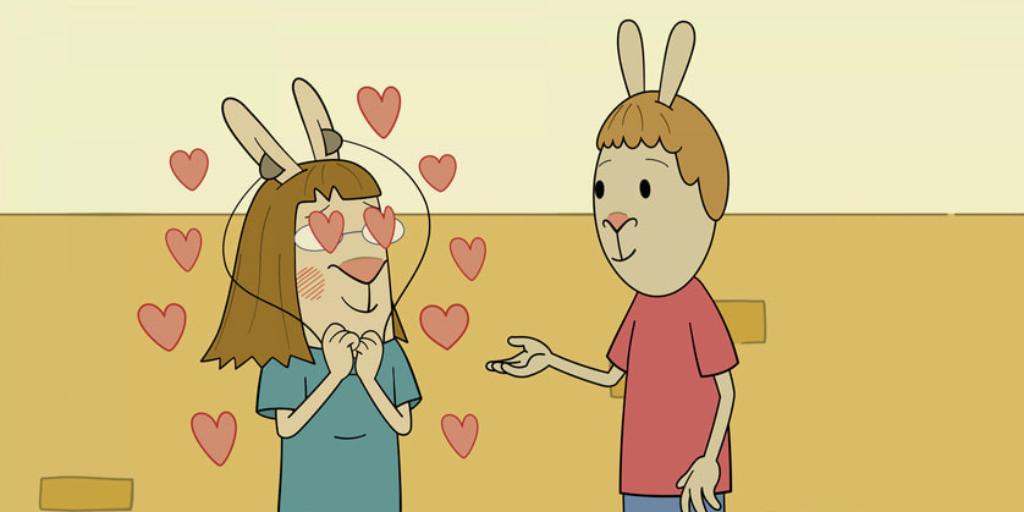
El Deafo is an animated miniseries based on a graphic novel. It tells the true story of the author who became deaf as a child following an illness.
El Deafo features authentic disabled representation with positive messages about recognizing one’s own strengths that will resonate with any child. The show encourages empathy, acceptance, and expressing emotions.
The scene where Cece is hospitalized isn’t scary, but it is emotionally intense. If your child has suffered medical trauma, you may want to warn them ahead of time, watch that episode together, and make space to talk about it afterward.
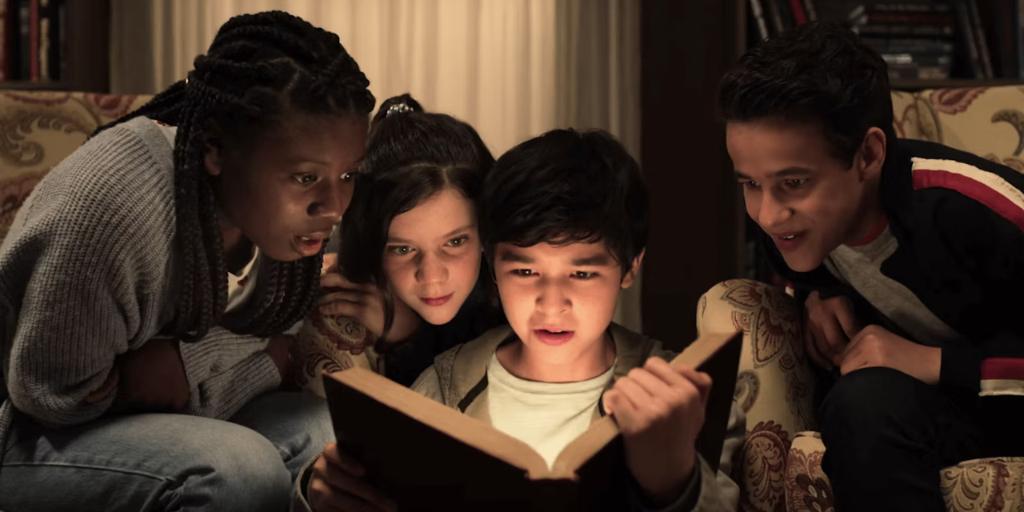
In this wholesome and fun reboot, a group of tween friends must solve the mystery of a ghost haunting their neighborhood bookstore — one that’s bringing fictional characters to life in the real world.
Ghostwriter is a well-written show that encourages reading by including characters and storylines that bring to life classic and modern books. It features a diverse cast, positive messages, and good role models.
Ghostwriter has no content considerations that parents need to be aware of.

This show follows tween Gortimer Gibbons and his two best friends as they navigate life on Normal Street, a seemingly ordinary suburb with a hint of something magical just below the surface.
A good, live-action show with tweens is hard to come by, which is why Gortimer Gibbon’s is such a gem. The series features strong values, quality friendships, and nurturing family relationships. Themes of compassion and teamwork along with positive adult role models are intertwined with engaging storylines.
In an effort to stop cursing, one of the characters uses stand-ins for curse words such as “son of a blueberry.” It’s innocent and funny, but be prepared for some copycat action.

This musical comedy-drama follows Julie, a teenager. While coping with the recent death of her mom, Julie reignites her passion for music with the help of a teen boy rock band whose members have been dead for 25 years.
This show deals honestly with issues like grief, sexual identity, and the social pressures of high school while remaining wholesome enough for the older elementary set. Characters explore their feelings and overcome their struggles with the help of strong support systems. The cast isn’t very diverse, but gets some points for a mixed female lead.
The original songs the band plays on the show are available for download. If your child has a tendency to purchase songs without your permission, take a second to update their purchase settings. If they have an Apple device, here’s how to set purchase limits using iPhone parental controls.

This reality TV series follows teams of two as they build creations out of LEGO based on an assigned theme.
It’s a fun, engaging show that parents will enjoy just as much as their kids. It features diverse competitors, an upbeat tone, and a supportive atmosphere. Builds are breathtaking and can spark creativity for viewers.
The show is heavily branded, so you can use the opportunity to help your child learn about the ways companies advertise their products to kids. While there’s no cursing, there is the occasional curse-adjacent word like “hell” or “damn.”

Masterchef Junior is a family-friendly cooking competition where kids ages 8 to 13 are given ingredients and instructions and must cook dishes within a time limit.
The adult host and judges are respectful and supportive of the young chefs. Contestants display tenacity under pressure and perseverance through obstacles. The contestants are very skilled, and many want to work with food when they grow up, which might just inspire your own budding chef.
Occasional mild language such as “hell” comes up.

This action-filled animated series is set in the world of Star Trek. It follows a group of alien teens in the 24th century who find the abandoned starship Protostar and embark on a quest for adventure and freedom.
The animated aliens represent a wide range of colors, shapes, and sizes, and the show features positive themes such as fighting for what is right. Despite their differences, the main characters come together to work or the common good.
The show features forced servitude and captivity, as well as violence using various weapons. It’s fairly mild overall, though.
Netflix, Prime Video, Apple TV+
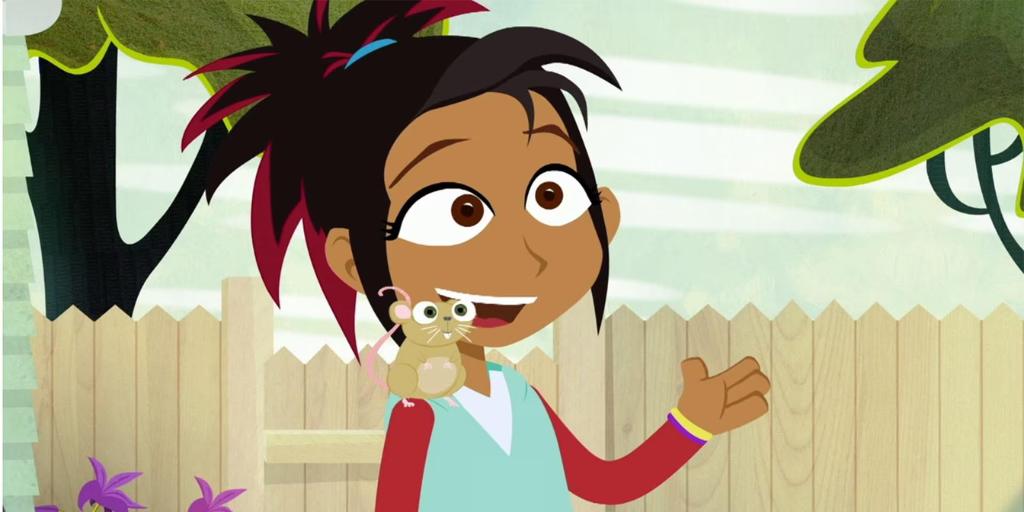
Each episode of this animated series follows a new group of tween girls curious about the world as they use science to solve a problem.
In a world where the STEM gap could still be considered a chasm, it’s refreshing to see a show that unabashedly strives to change how girls view traditionally male-dominated fields. SCIGIRLS is filled with positive messages and role models, and episodes show kids the scientific process through various disciplines.
SCIGIRLS has no content considerations that parents need to be aware of.

Tiny World is a visually stunning nature documentary series that spotlights the smallest members of the animal kingdom in their extraordinary quests to survive and thrive.
This is an outstanding show that the whole family can enjoy together. It educates kids about often unseen parts of nature and inspires in them a curiosity about the natural world.
Nature being nature, you will see a fair amount of animals in danger, such as animals being pursued by predators. However, no animals die, and nothing too graphic is shown. There are references to animals mating, so be prepared to answer questions, but no visuals are shown.
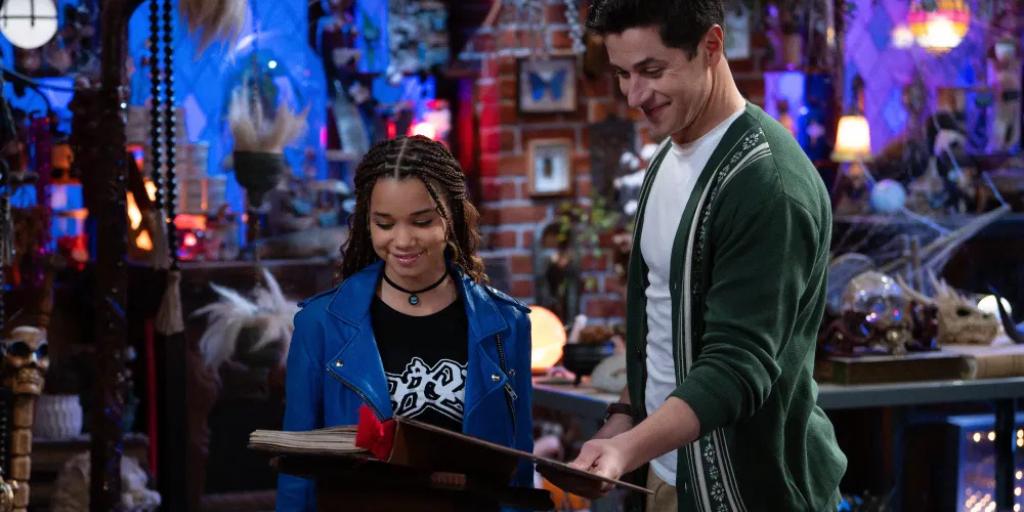
In this the sequel to the 2007 Disney Channel sitcom Wizards of Waverly Place, Justin Russo, a former wizard who has traded in magic for a normal life, finds himself pulled back in when Billie, a powerful young wizard, shows up at his door in need of help.
We love that Billie is a strong, young, Black female lead. While her rebellious streak and troublemaker tendencies mean she’s not exactly perfect, this also makes her realistic and relatable. Justin is a positive adult role model, and Billie is open to learning and shows personal growth, so the show’s message is ultimately positive. We also appreciate that Justin defies masculine stereotypes as a dad who manages the family’s calendar, sews, and cooks.
The Wizards encounter some monsters (although they lean more silly than scary) and find themselves in occasional danger. There are some mild insults like “dumb” and the occasional stand-ins for curse words like “freaking,” but overall, the language is clean. There are a few innuendos like “get a room,” but these will go over many kids’ heads.
As with any new media your child consumes, we recommend checking out the show ahead of time — or watching it with them. It’s also a good idea to stay informed about what your child watches and searches online. With BrightCanary, you’ll be able to see if their YouTube searches send them down a rabbit hole of concerning content, or if their friends are sending them content they’re not quite yet ready to see. Download BrightCanary on the App Store and start your free trial today.

Dating apps for teens? You might be wondering if your eyes deceived you with that headline. Unfortunately, they did not. Modern technology has dramatically changed the way teens date, most notably by shifting a lot of their interactions to digital spaces. This romantic migration online has been followed by a suite of dating apps designed specifically for teens.
Does the idea of your teen looking for love on the internet give you the heebie-jeebies? It should. Parents need to be aware of the dangers of dating apps for teens and take steps to keep their child safe.
There are three major categories: apps specifically geared toward teens, apps open to both adult and teen users, and apps meant only for adults but that have easy-to-bypass (or non-existent) age verification.
Dating apps expose teens to a whole host of risks. Here are the dangers parents need to know:
Is there a safe dating app for teens? While some apps market themselves specifically for younger people, they also come with major risks. Here are a few parents should know about.
While Yubo insists it’s not a dating app (they bill it as a way to find friends), many people use it to look for love. The app even uses a swipe system reminiscent of Tinder. The app has a version for teens and one for users 18+, but the majority of users are 13-25.
Hoya is marketed as a dating app for Gen Z, with a tagline of “Chat, Date & Hook Up.” The minimum age for users is 17.
OurteenNetwork is a dating app for teens that lets users find people by their social media handles, such as their Snapchat username.
Although parents need to be aware of the dangers of dating apps for teens, there are steps they can take to protect their child.
Dating apps for teens expose kids to risks such as online predators, sexploitation, and inappropriate content. Parents need to be aware of the dangers and educate their children on the potential harms. It’s also important for parents to monitor their child’s online activity so they can step in if there’s an issue.
BrightCanary can help you supervise your child online. The app’s advanced technology scans what your child sends on all the apps they use and sends you real-time alerts for concerning content. BrightCanary provides the broadest coverage across Apple devices, too. Download the app and get a free trial today.
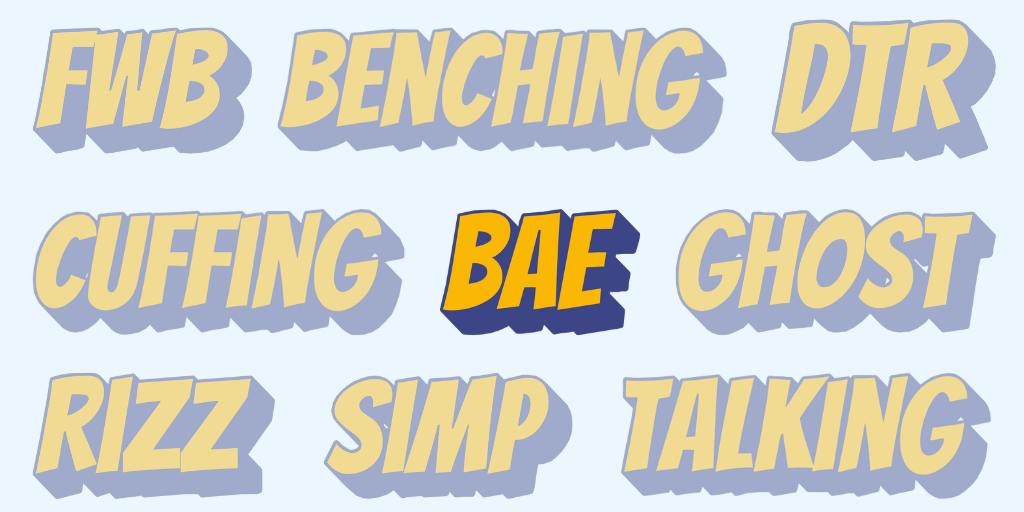
When it comes to keeping a watchful eye (or ear) on your teen, you’re on it: You monitor their social media, you supervise their phone, and you’ve perfected the fine art of the car chat. But we all know there’s a big difference between knowing what your child is talking about and actually understanding what they’re saying — especially if they’re starting to show interest in dating and relationships. That’s why we’ve put together this handy guide to teen dating lingo to help you decipher what all those messages mean.
Here are some of the more common teen slang terms related to dating, sex, and relationships:
53X: Sex
Bae: Short for baby or an acronym for “before anyone else.” Often used to refer to a romantic partner, but can be used for a good friend.
BBG: An abbreviation for baby girl and used to refer to someone cute.
Beige flag: A quirky or odd trait in a romantic partner. Like the color, a beige flag is seen as neutral — not a deal-breaker, but also not a plus. Beige flags are simply something to note.
Benching: Drawing from sports lingo, to bench someone romantically means to set the person you’re dating aside and see other people.
Beta testing: Similar to the process for testing software, this analogy usually refers to a trial phase of dating. Someone who’s beta testing might casually date as a way to practice their dating skills, explore compatibility, and figure out what they’re looking for in a romantic relationship.
Body count: The number of sexual partners a person has been with.
Catch feels: To develop romantic feelings for someone.
CU46: See you for sex.
Cuffing/cuffing season: Cuffing means to get into a relationship. Cuffing season refers to the winter, when people are looking for someone to stay home and snuggle with.
Curve: To reject or ignore someone’s romantic overtures.
DTF: Stands for “down to f**k.” DTF refers to a person's willingness to engage in sexual activity.
DTR: Stands for “define the relationship.” This usually happens after the “talking” phase (see below), when it’s time to decide whether or not to make things official.
FBOI: An abbreviation for “f**kboy.” This is a derogatory term for a promiscuous male who uses lies and manipulation to get sex.
FWB: Stands for “friends with benefits.” This is an arrangement where two people are sexually involved without being in a romantic relationship.
Ghost: To dump someone or cut off communication with no explanation.
GYAT: An abbreviation for “girl your a** is thick.” It can also mean “goddamn.” It’s an expression of admiration, typically about someone’s rear end.
Pink flag: A step down from a red flag. Pink flags may not be instant deal-breakers, but they can signal the relationship isn’t especially healthy.
Rizz: Short for charisma, someone with rizz is charming or has “game.”
Sigma male: A sigma male is cool and popular, but he’s also an introverted lone wolf and often a bit of a bad boy.
Simp: A “try-hard” who’s desperate for affection, or an insult for a man who is seen as too submissive to women. This term is generally considered degrading.
Situationship: Two people who aren’t officially together, but who have romantic feelings for each other and may be moving in that direction.
Smash: To have casual sex or hook up.
Snack/snacc: An attractive person — someone who looks “good enough to eat.”
Sneaky link: A secret hookup.
Talking: The talking phase is the step between flirting and making things official when two people step up their texting and communication, but aren’t ready to be exclusive yet.
Thirsty: Desperate or over-eager for attention or sex.
Thot: An acronym for “that ho over there.” A derogatory term for a female who’s seen as promiscuous or sexually active. Can also be used as an adjective, as in thotty.
Whole meal: Someone who looks really, really good. A step up from a snack/snacc.
Zaddy: An attractive, stylish (usually older) man.
Zombie-ing: This happens after being ghosted, when the person “comes back from the dead” and tries to pick up again like nothing happened.
Why use words when a picture will do? Teens and emojis are a language of their own. Here are the dating and sex emojis you’ll want to know:
🍆: Penis
🍑: Butt
🐫: Sex (aka “humping”)
🥵: “Hot” in a sexual sense
🚛: “Dump truck,” which refers to a large and/or shapely bottom
🌮: Vagina
🧠: Oral sex
🖐🏻🍆: Handjob
💦: Ejaculation or orgasm
💦 👊: Masturbation
👅: Oral sex
🌮👅: Oral sex, specifically on a female
🤤: Desiring someone sexually (often used in response to nudes)
🍒: Breasts/testicles/virginity
🍝: Nudes, which are often called “noods”
🔨: Sexual activity
🌽: Represents “porn,” especially on TikTok
🎪: Erection
What should you do if you find these terms on your child’s phone? In general, it’s a good idea to set rules about dating and talk with your teen before they start going out with anyone. You might get a lot of eye rolls and groans, but it’s important to discuss expectations ahead of time.
After all, it’s normal for teens to show interest in relationships and dating. You can reiterate your family values and boundaries by sharing how much you want to be involved; for example, if they’re interested in asking someone out, explain that you’re willing to drive them, but only if they follow certain rules. Or if you feel they’re too young to date, explain your reasoning.
For a lot of teens, “dating” just means talking. But if those conversations involve inappropriate content, have a plan about how you’ll handle it. BrightCanary is a go-to resource for thousands of parents today. The app monitors what your child messages across all the apps they use, including Snapchat and Instagram, and flags anything concerning in real-time. You'll get insights, transcripts, and more, all on your phone. Download BrightCanary today and get started for free.
Learn about what to do if your child sends inappropriate pictures and what to do when your child sends inappropriate texts.

Looking for the best app to monitor a teenager’s iPhone? With 87% of teens using iPhones daily, it’s essential to find a parental control solution that’s effective on Apple devices. Here’s a detailed guide to the best parental control apps on iPhone in 2025 — plus everything parents should know about how to use these tools to keep their kids safe online.
Teens spend hours on their iPhones daily, so protecting them online requires the best tools to supervise their digital activities. For each of these apps, we’re laying out what makes them great and where they fall short so you can make an informed decision.
You can think of Life360 as location tracking-plus. In addition to viewing your teen’s location, you can use the app to see things like your child’s phone battery life, ETA, and driving speed. The app also offers extra features like identity protection and stolen phone protection at higher price points.
Limitations: Life360 works very well on the iPhone, but its features are limited. Without the ability to access any other apps or data outside of Life360, the parental control options are limited to its tracking features.
Life360 works well on the iPhone, but its parental control options are limited to its tracking features. It doesn’t offer tools for monitoring apps, texts, or online activity.
Bottom line: If you have a new driver on your hands and want to help them stay safe on the road, Life360 is a fantastic choice. But for robust parental controls for when they reach their destination, you’ll have to look elsewhere.
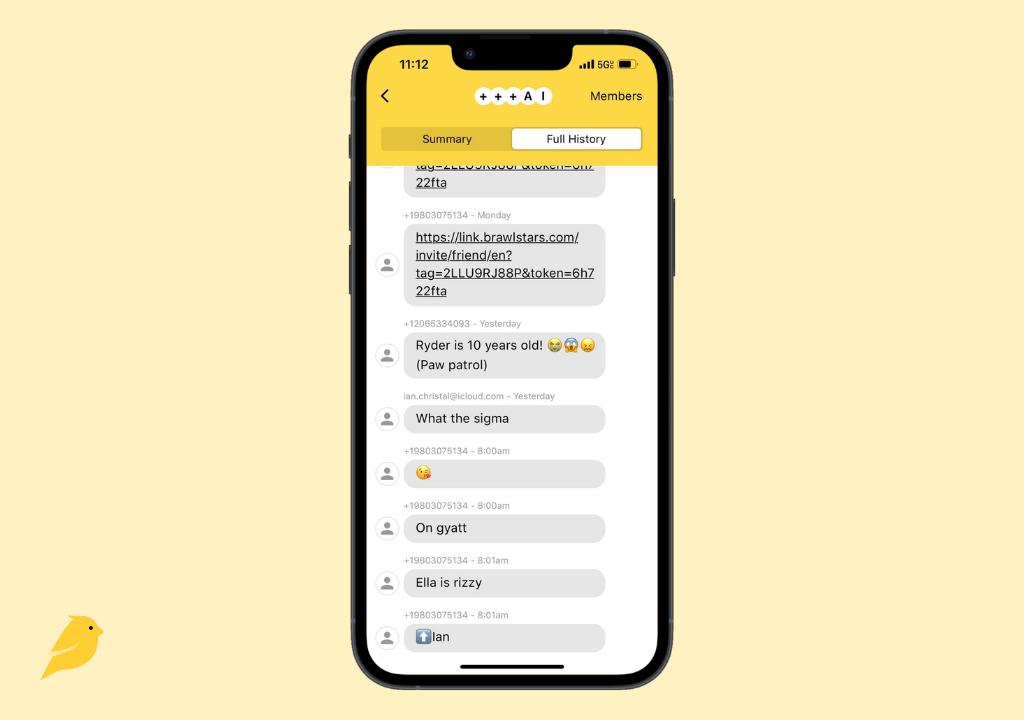
When it comes to the best parental control apps for iPhone, BrightCanary stands out from the pack. BrightCanary uses advanced AI technology to monitor your child’s text messages, YouTube, Google, Instagram, Snapchat, and every other app they use.
BrightCanary uses a safe and secure keyboard, installed on your child's device, to monitor what other apps can’t on iPhone. Some apps can only scan content when your child is connected to the same WiFi as you, which is challenging when they’re not home. BrightCanary is different: the app continuously monitors what your child types, searches, and sends whenever, wherever, and alerts you when you need to get involved.
Limitations: BrightCanary is not a traditional parental control app in the sense that you can use it to set screen time limits or content filters. Those features are freely available on Apple Screen Time. If you want an all-in-one app, this one doesn’t quite fit the bill.
Bottom line: BrightCanary is one of the most effective options to monitor a teenager's iPhone because it captures everything they type and send, no matter which app they use. The AI-generated insights are also helpful to learn more about your child's interests and well-being. Parents also love the Text Message Plus monitoring feature, which shows full text message conversations, deleted texts, and images and videos in text threads.
Qustodio wins points for offering very similar features and functionality for iPhones as it does for Android devices. Parents can use Qustodio to set limits on apps and block kids from using specific apps and websites.
Limitations: Qustodio’s monitoring capabilities only alert you when your child tries to access something you’ve already blocked. While the app is effective for restricting access, it lacks tools to monitor ongoing social media activity.
Bottom line: If you want to allow your child to be able to use the internet with guardrails, Qustodio may be an option. But if you’re looking for an app that also provides detailed insights into what your child does online, Qustodio may not be enough for you.
With Norton Family, you can block your child from accessing specific websites or content and get insight into their online activity. The reports show you what search terms your child uses and their browser history. It also alerts you if they attempt to visit a blocked site.
Limitations: Similar to Qustodio, the only option for managing social media is to block your child from the sites entirely. This is a good option for younger kids, but may not be the best choice for teens. One major drawback for Apple users is that Norton Family doesn’t provide any app supervision for iPhones.
Bottom line: Norton Family offers solid content filtering and online activity tracking, but isn’t great for families who need to monitor apps on iPhone.
Similar to BrightCanary, Bark uses advanced technology to scan texts, social media, and other online material for concerning content, alerting parents when there’s an issue. You can also do things like control app downloads and require approval for new contacts.
Limitations: While Bark can scan content on Android devices anytime, it can only manually scan iOS devices when they're connected to the same network as a desktop with the Bark for Parents app installed and active.
Bottom line: Bark might be suitable for monitoring a device used only at home, but it falls short in tracking your kids' iPhone usage wherever they go.
On average, children in the U.S. spend more than four hours a day on devices, with teens often clocking as many as nine hours. With such a significant portion of kid’s lives being lived online, it’s important that parents use every tool available to them to keep their kids safe from things like online predators, cyberbullying, and inappropriate content.
Recently, the American Psychological Association recommended that parents monitor social media for kids under age 15. That’s because excessive social media use is associated with an increased risk of depression and anxiety, as well as negative impacts on sleep quality and self-esteem. Parents can and should use parental controls to manage the amount of time kids spend on their devices and understand what type of content they consume.
Choosing the right parental control app depends on your needs. Start by deciding what features are important to you: if you’re just looking for powerful location tracking, but are less worried about content monitoring, an app like Life360 might be perfect for you.
For parents who want comprehensive iPhone parental monitoring — including social media, texts, and searches — BrightCanary provides unmatched functionality.
Above all, the best parental control app is the one that works best for your family.
Some apps rely on a block-and-restrict approach, but Apple devices already come with robust parental control features that allow you to restrict what websites, apps, and content your child can access. Other parental control apps, allow parents to monitor what their kids do online and step in when they need to. This level of iPhone parental monitoring can help teach your kids how to be safe and responsible digital citizens, and it encourages more regular conversations about what they see online.
Ready to ensure your teenager’s iPhone safety? Download BrightCanary today for the best in iPhone parental controls.
BrightCanary offers the most robust iPhone parental monitoring features, including text message and social media monitoring.
Apple’s Screen Time is free and offers basic restrictions, but it lacks advanced monitoring capabilities like the ability to see what your child is sending and receiving.
Yes, apps like BrightCanary allow parents to monitor texts, including deleted messages.
Most apps block social media entirely, but BrightCanary monitors all social media and messaging platforms, including Instagram, Snapchat, Roblox, and Discord.

Who among us hasn’t scrolled through social media and felt that particular combination of jealousy, anxiety, and unease from seeing the fabulous things others are doing in their fabulous lives with their fabulous friends? Now, imagine experiencing that as a teen. (I shudder at the thought!)
The fear of missing out (FOMO) can lead to negative mental health consequences in adolescents, such as anxiety and even a decline in academic performance. It’s important for parents to take steps to combat the impact, especially when their kids begin connecting with friends online. Here’s how to deal with FOMO and strategies to help lessen its impact.
FOMO stands for Fear of Missing Out. The term refers to the fear of not being included in something fun, interesting, or enjoyable that others are doing, particularly peers.
The acronym has been around for more than 20 years and has even earned a place in the dictionary. But its impact on teens is more relevant than ever because teens today have more access, more visibility, and more difficulty getting away from what their friends are doing online.
FOMO can make kids anxious about being excluded. It can also lead them to perceive their lives as less exciting than those of their peers, which can further exacerbate their anxiety.
Research has shown that FOMO can lead to compulsive social media use. That is a significant trigger for social media fatigue, resulting in elevated anxiety and depression.
FOMO is also associated with problems sleeping, depression, attention span, and negative impacts on physical well-being. In short: FOMO isn’t just something your child is dealing with among their friend group. It can have real and lingering effects on their mental, emotional, and physical health.
While the term FOMO may be a 21st-century invention, the phenomenon is certainly not new. It is, however, made much thornier by the existence of social media.
The constant exposure to a carefully-curated window into the lives of their peers and the resulting comparison to their own messily real life is enough to make any teen feel FOMO. But it’s not as simple as just logging off to feel better.
Because so much of the social lives of teens has shifted online, kids can also feel like they’re missing out if they’re not constantly checking their social feeds or group chats. It’s a double-edged sword that’s tricky for teens to escape.
Here are some potential red flags that could indicate your child is struggling with FOMO:
If you suspect your child is dealing with FOMO, here are some ways you can support them:
Focus on your relationship with them. Research suggests that relationships between parents and their teens that are based on trust and open communication are powerful protective factors against FOMO.
Limit social media use. Delaying access to social media, setting limits on device use, and helping kids develop a balanced relationship with social media can help minimize FOMO’s negative health effects.
Encourage real-life activities and relationships: Simply removing or cutting social media access for your child isn’t likely to help. It may lead to tech envy and the fear of missing things online. Instead, replace the connections that social media brings them with offline alternatives. Offer to drive your teen to see their friends or host a hangout at your house. Encourage your child to explore screen-free interests and hobbies, particularly ones that get them out of the house and around other people.
Help them see through the facade. Explain that people tend to show their best moments online, often omitting a big part of the picture. For example, teens may post pics of getting ready to go out with the girls, but fail to mention the party was totally lousy when they got there. Remembering that they never have the full context when looking at other’s social media can help kids overcome the feeling that they’re missing out.
Create space for digital detoxes. By establishing household expectations around device use, you provide a structure for daily digital detoxes. Play around with what works for your family, such as phones off an hour before bed or no devices at the dinner table.
Practice digital check-ins. Set aside designated time to spend with your child looking at their social media feeds together. Ask them how their feeds make them feel and check in with them about any big feelings they’re struggling with, like feeling left out or unsure how to spend their time.
Monitor their social media use. BrightCanary uses advanced technology to monitor your child’s social media and texts and alerts you to any issues. This can help you spot signs of FOMO (like comparing themselves to others or feeling sad they aren’t going to a party) so you can start a conversation with your teen. It’s a great compliment to your other efforts to support your child in the digital world.
FOMO can have a negative impact on the mental health and wellbeing of kids. Luckily, there are steps parents can take to mitigate the effects of FOMO and guide their child toward healthier habits around social media and devices. BrightCanary helps parents keep their kids safe and on track across every app they use. You'll get real-time updates for any concerning content, so you'll know when it's time to step in and provide support. Start your free trial today.
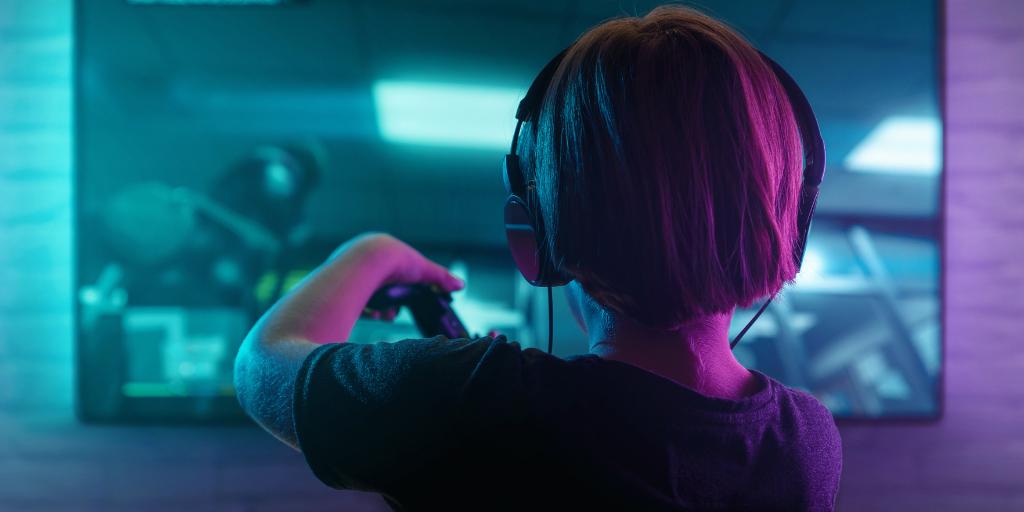
Contrary to outdated (and unfounded) assumptions that video games rot children’s brains, research shows gaming has a host of potential cognitive benefits for kids. But not all games are suitable for children, so parents need to be discerning about what makes its way to their kid’s screen. Here’s a list of five kid-friendly video games that your children will enjoy and parents can feel good about letting them play.
Pode is a character-based puzzle game that starts out simple and grows in complexity as a player progresses.
Pode is visually stunning and manages to be both fun and relaxing at the same time. It's designed as a cooperative adventure, but it is also enjoyable to play solo as well. Characters are filled with personality, and the game focuses on friendship and teamwork.
There are no content or safety concerns that parents need to be aware of with Pode.
For the first time in this popular game’s long and storied history, Princess Zelda comes out of the shadows and replaces Link as the protagonist.
Echoes of Wisdom encourages creative problem-solving, resourcefulness, and out-of-the-box thinking. It’s empowering to see the princess take the reins for once and themes of gender equality, responsibility, and compassion are threaded throughout. Because Zelda primarily uses her wand instead of the more traditional weapons Link carries, this game features less combat than its predecessors.
There’s a small amount of violence, but it’s quite tame. The fanciful enemies, cartoonish violence, and lack of blood and gore keep things light. When enemies are defeated, they just disappear.
Super Mario Bros. Wonder is a traditional side-scrolling Super Mario game with fun updates and modern graphics.
It’s been over a decade since the last side-scrolling addition to the Mario Bros franchise and friends, it was worth the wait. The graphics in this game are nothing short of amazing. Players can choose from a full arsenal of Nintendo characters to embody and even spend time as a delightfully rotund, water-shooting elephant (so fun!).
Super Mario Bros. Wonder is nostalgic without being dated, and it’s likely to be a hit with the whole family. The multiplayer option (either locally or online) promotes teamwork, and the story is centered around working together for the common good.
Like you’d expect from Mario games, there are enemies to defeat, but they’re cartoonish and non-human. The implication is that enemies are just knocked out or knocked off-screen, rather than being killed. Online play is possible, so make sure you’ve set up Nintendo parental controls, especially for younger kids.
This game is a baseball simulation that lets gamers play as their favorite MLB players and teams. It’s the latest installment in a popular series, with improvements over the older versions, including updates to reflect recent league rule changes.
What could be more wholesome than baseball? Amateur players and professional fans alike will enjoy suiting up and going head-to-head with rival teams. Players can even use historical mode and play in the Negro Leagues or (new with this edition) in an all-female league. Cross-platform play is also possible, so your kid can join their friends regardless of their gaming setup.
There are no content considerations for parents to be aware of, but in-app purchases are possible.
This point-and-click adventure is based on the classic Nancy Drew mystery novels. Players take on the role of junior detective Nancy Drew to solve mysteries using her ultimate superpower: her brain.
Nancy Drew: Mystery of the Seven Keys is a fun way for your kids to learn about historical events and figures, as well as other cultures, languages, and customs. They will practice critical thinking and problem-solving as they work to catch the culprit.
There violence in the game, but it’s mild.
Parents should be aware of what video games their kids are playing to make sure the content is age-appropriate, but there are plenty of wholesome and fun options for kids to enjoy.
Heads up: BrightCanary can help you supervise your child’s online activity. While it doesn’t cover gaming platforms, the app’s advanced technology scans your child’s social media, Google, YouTube, and text messages so you can keep an eye on what media they’re consuming online — like video game playthroughs on YouTube and conversations with the friends they game with. Download the app today to start your free trial.

A video game where you can play as your favorite Marvel character is a dream come true for fans of the Marvel universe. Since it was released in early December, Marvel Rivals has taken the gaming world by storm. Your child might want to play the game because it features their favorite superhero, but is Marvel Rivals appropriate for kids? Here’s what we found.
Marvel Rivals is a 3rd-person shooter video game where players can choose from a lineup of 33 characters from the Marvel universe. Players join teams of six and face up against another team to see who can be the first to accomplish an assigned task. The game is available for PlayStation, Xbox, and PC gaming systems.
The Entertainment Software Rating Board (ESRB) gives Marvel Rivals a rating of T for Teen.
For many games, the ESRB puts a rating summary and content descriptor on their website to give insight into their decision. Because every family has different values and concerns that they take into consideration when making content decisions for their child, this additional information is helpful.
However, as of the writing of this article, the ESRB has yet to post anything for Marvel Rivals. The game is so new that Common Sense Media, a solid go-to for parents looking for in-depth media information for their child, hasn’t reviewed the game yet, either.
The closest comparison to Marvel Rivals is Overwatch, which is similar in game mechanics and content. Common Sense Media rates Overwatch as ideal for players 14+.
Keeping with the historically tame language from Marvel (although they’ve pushed boundaries more in recent years), there isn’t any questionable language to speak of in Rivals. The closest is Rocket Raccoon’s use of “flerken” in place of the F-word.
There’s no sex in Marvel Rivals. While some female characters wear costumes that reveal their cleavage or backsides, it’s nothing to raise an eyebrow over (unless you’re ultra-conservative in that regard).
The biggest concern parents need to be aware is that Marvel Rivals is a team game, played online, often against strangers. Like many things that require working together, people can get quite heated at each other, and the chat can become downright toxic.
This is compounded by the fact that voice chat is the default in the game, so your child could easily end up with a full-grown adult berating them through their screen. (There’s also a text chat option.)
Luckily, you can turn off both voice and text chat. In this case, a player is still able to use preset “pings” to alert their teammates when they need help. For an added layer of protection, your child can avoid playing with strangers altogether and use practice mode against AI players.
As one might expect from a game based on superheroes, there’s quite a bit of violence in Marvel Rivals. However, the violence is cartoonish and void of blood and gore. A few characters have intense, realistic-looking guns, which may give parents pause. However, there are also plenty of characters your child can choose from who use things like slingshots, fists, or non-weapon abilities to fight.
Although killing is a big part of the game, it’s also not the main point. The team's primary goal is to accomplish an objective, such as pushing a vehicle across a map or defending a specific zone. Also, when characters are “killed,” they just run out of health, fall over, and then respawn indefinitely.
When deciding if Marvel Rivals is appropriate for your child, the easy answer would be to follow the ESRB rating and wait until they’re 13. However, a closer examination reveals a more nuanced choice.
With measures such as turning off chat, requiring your child to stay in practice mode against AI, and monitoring their play, the game can be a fine choice for a mature tween or older elementary-age kid. It’s helpful to draw a comparison to PG-13 movies. PG-13 doesn’t mean a movie is never appropriate for any child under thirteen. Instead, it suggests parental guidance is advised if younger children do watch it. The same can be said for Marvel Rivals.
While it’s not a great choice to let your child loose on the game by themselves with no restrictions, parental involvement mitigates many of the concerns.
Marvel Rivals is a 3rd-person shooter game played with teams made up of Marvel characters. While there are some elements that raise concerns for kids, parents can take steps to make play safer for their child.
BrightCanary can help you supervise your child’s online activity. While it doesn’t cover gaming platforms like Xbox or PlayStation, the app’s advanced technology scans your child’s social media, Google, YouTube, and messages so you can keep an eye on what media they’re consuming online — like video game playthroughs on YouTube and what they send to the friends they game with. Download today to start monitoring for free.

You’d practically have to be living under a rock to not know that artificial intelligence (AI) has exploded over the past few years. From answering questions to planning vacations, technologies like ChatGPT and Claude are firmly a part of everyday life. But did you know that there is some great AI for parents that can help you improve your communication with your child?
At BrightCanary, we believe that AI can be harnessed to help parents maneuver difficult situations with their children. In fact, we’ve built our app around this premise. Here are several ways BrightCanary’s AI tools can help you in your parenting journey:
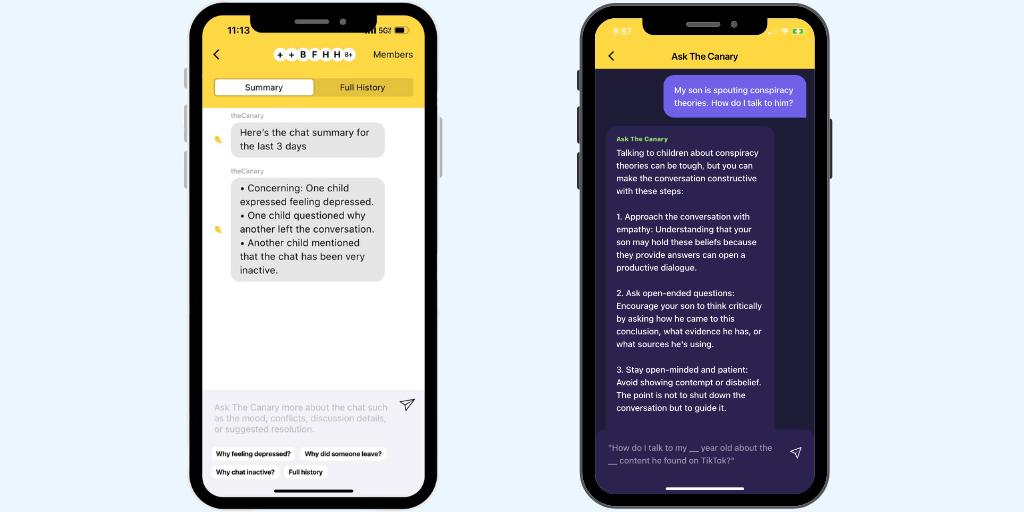
Ask the Canary is a chatbot powered by large language model (LLM) algorithms, which scrapes the internet to generate relevant answers to your questions. Instead of Googling your question and then wading through page after page of info to find something useful, Ask the Canary is designed to answer your question for you. So instead of spending hours looking for help, you’ll get useful, targeted advice and practical solutions in a matter of seconds.
Let’s face it: knowing how to broach difficult subjects with our kids is hard. We’re worried we won’t be helpful or that we might say the wrong thing and actually make the situation worse. That’s where AI can be really helpful — it functions as a sounding board, helping you to brainstorm different conversation-starters and directions.
To test it out, I posed some questions to Ask the Canary to see what it suggested. Here’s what I found:
My prompt: “I got an alert on BrightCanary that people are sending hurtful texts to my child. What are some conversation starters I can use to talk to them about it?
Ask the Canary’s response: “I noticed some of your friends have said hurtful things in your text messages. How does that make you feel?”
My prompt: “My child is posting inappropriate things online. What are some conversation starters I can use to talk to them about it?”
Ask the Canary’s response: “I noticed something that worried me in your posts. What was your intention when you posted this? How do you think these posts align with the values we cherish as a family?”
My prompt: “I want to know more about a show my child is watching. What are some conversation starters I can use to ask them about it?”
Ask the Canary’s response: “Can you tell me about the show you’re watching? How does this show compare to other shows you like?”
No matter how I posed my questions, Ask the Canary came back with useful advice. But I did notice that certain things helped me get even more out of the experience. Here are some tips:
When facing difficult parenting situations, it’s hard to know what to say to your child. Luckily, there are some fantastic tools using AI for parents that can help. Ask the Canary provides targeted advice on your toughest parenting questions right from your phone, including ideas to help you have better conversations with your child. All you need is the BrightCanary app to get started.

Ah, oversharing about your personal life online. We’ve all seen it, and most of us have done it a time or two as well. But when it comes to our kids, oversharing on social media can be particularly risky. Here’s everything you need to know about the dangers of oversharing online and how to help your child avoid it.
Oversharing is saying something personal or inappropriate, either in the wrong setting or to the wrong person.
For example, it might be perfectly fine for your teen to discuss a sensitive family situation one-on-one with their best friend. But you may not want them telling their entire homeroom. And you almost certainly don’t want them blabbing about it on their Instagram.
Kids may not be aware that they’re oversharing — they may simply want to talk about their experiences with their friends, without realizing that the information is public or can be easily screenshotted and shared.
In other instances, kids may overshare because they’re actually being scammed or swindled. A scammer might convince their victim to share personal details, like their passwords or bank information.
The act of oversharing is as old as time, but the digital era has introduced new risks to the behavior. Here are some of the dangers oversharing poses to kids:
The uncomfortable truth is that it’s shockingly easy for kids to overshare online. Here are some ways your child might fall into the TMI trap:
Captions. Photos and videos. Stories. Social media is where your mind probably goes first when you think of oversharing online. And rightfully so — it’s incredibly easy to overshare on social media posts.
One way this can happen is through sadfishing, or oversharing about their personal life with the goal of eliciting sympathy. Sadfishing can have unintended consequences, like making a situation seem more dire than it actually is or feeding into a child’s attention-seeking behavior. Not to mention, they may regret the post once their emotions calm down.
Your child’s social media bio can also divulge personal information, even if their account is private. Including things like their age, where they live, their school, and even hobbies can put them at risk.
If your child’s accounts are set to public, anyone can view what they post — from YouTube to Pinterest. This means content meant for a small group of followers could end up being seen by the wrong audience.
For example, if your teen uses Reddit, their comment history is publicly visible. While they may use the platform to connect with friends or share interests, a stranger could piece together personal details if your teen frequently posts about their location, friends, family, or health information.
It’s easy to assume that text messages and direct messages are only visible between the people on the thread. But anyone in the group can take a screenshot and forward it to others or post it on social media.
It’s common for people to post about what they’re doing while they’re doing it. This is especially problematic on places like Instagram Stories and Snapchat, because other users are likely to see it in real time. If the post includes their location, it can put them at risk because it reveals their whereabouts or a place they frequent.
From your child’s profile picture to the images they share on public accounts, the things in their background can reveal a lot about their personal life.
A photo or video while on campus can provide clues about where they go to school. Posters on their bedroom wall or knickknacks on their shelf can point to their interests. A picture in the front yard with the house number visible behind them can help someone figure out where they live.
With all the risks and the potential for kids to accidentally overshare, it might feel tempting to shut down online access altogether. We understand. Instead, focus on teaching your child to avoid sharing certain types of sensitive details online:
The best way parents can address oversharing is by being proactive and having conversations with their kids before it becomes an issue. Here are some tips for discussing oversharing with your child:
Oversharing online poses significant risks to kids. It’s important to educate your child about the dangers of oversharing and teach them to not disclose personal information online. You should also help them understand the surprising ways they may be oversharing without even realizing it. BrightCanary can help you keep an eye on your child’s online activity by monitoring their social media and text messages so you can watch out for oversharing, signs of cyberbullying, and more. Download the BrightCanary app and start your free trial today.